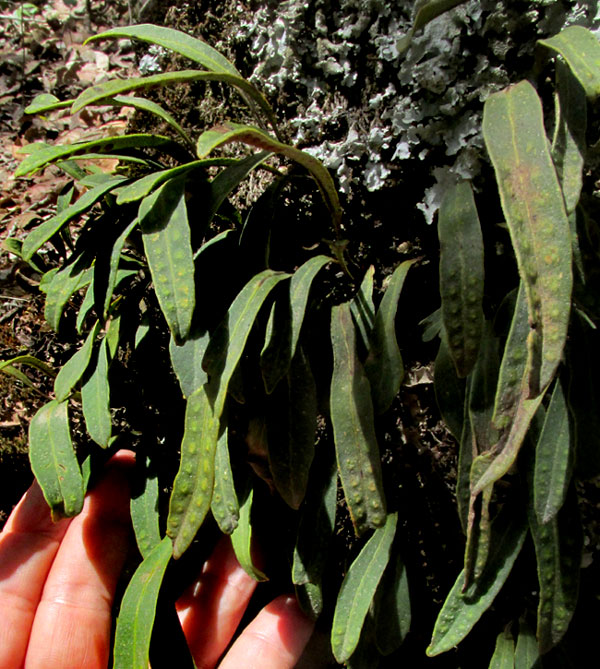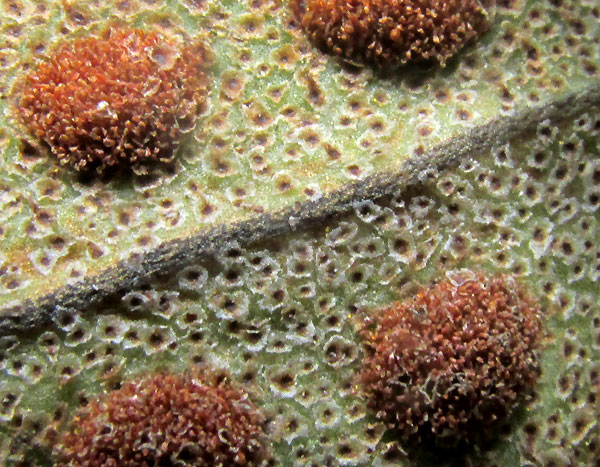Excerpts from Jim Conrad's
Naturalist Newsletter
entry from field notes dated June 28, 2022, taken in an oak forest on the slopes of Cerro de la Cruz, elevation ~2750m (~9000 ft), rising on the south side of the community of El Pinar, Amealco de Bonfil, Querétaro, MÉXICO, (~N20.17°, ~W100.17°)
REDSCALE SCALY POLYPODY

Along a steep footpath winding through the oak forest on the north face of Cerro de la Cruz, climbing toward the towering metal sculpture of Jesus on the Cross at the very top, the small fern shown above commonly appeared on tree trunks. This fern's fronds are not at all "ferny" -- not subdivided into pinnae. Nor do they even have lobes or indentations along their margins.
However, the small, round bumps on the fronds' upper surfaces indicate that this really is a fern, for the bumps rise above sori on the frond's undersurfaces, and only ferns and certain algae and fungi produce sori, and here we certainly don't have an alga or a fungus. Fern sori consist of clusters of grainy-looking, spore-producing sporangia such as those seen below, where they're lined up along a frond's midrib:

This fern's fronds are fairly small, with not much of a stem, or stipe. It's noteworthy how the sori appear only on the outer end of the frond, and align themselves midway the frond's midrib and margin. The dark specks between the sori also are worth looking at closely:

The scales are of a special kind, silvery on the margins but dark brown in the center, and they're attached to the frond's surface at their centers. Such center-connected, umbrella-like scales are said to be "peltate," and most fern species don't have them. Also, on this species the scales are so close together that many of their edges overlap the edges of neighboring scales. Most fern species which bear peltate scales don't have them crammed so close together.
These details and others lead us to the species PLEOPELTIS POLYLEPIS, which sometimes is known as the Redscale Scaly Polypody. The species occurs from southern Texas south through the uplands of Mexico and Central America, into northwestern South America. As presently conceived, the genus Pleopeltis is thought to embrace about 50 species occuring in tropical and subtropical regions worldwide. Pleopeltis species are mostly epiphytic, but sometimes on rock, and more rarely terrestrial.
In Mexico, where folks often call this fern Lengua de Ciervo, or "Deer's Tongue," Pleopeltis polylepis traditionally has been used to treat fever, bleeding, typhoid, cough, pertussis, chest pain and diseases of the kidney and liver. In 2016 Angel V Contreras Cárdenas and others published a study entitled "Antimicrobial, cytotoxic, and anti-inflammatory activities of Pleopeltis polylepis." From chopped-up fronds they obtained extracts with hexane, chloroform and methanol, and tested the extracts on various pathogens and human-derived cell lines. They summed up their results by concluding that "The benefit of P. polylepis as a traditional plant related to its antimicrobial and anti-inflammatory activities was confirmed by in vitro assays."